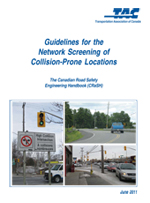Recognizing that collision-prone location (CPL) screenings depend on a number of variables as well as the needs and approach of each agency, Guidelines for the Network Screening of Collision-Prone Locations features recommended and interim screening methods including methodology, illustrations, and, where possible, implementation steps such as the development or acquisition of analytical tools. This publication will help practitioners and safety consultants use network screening analytical procedures and statistical concepts to identify and prioritize locations with the highest potential for safety improvement. Road authorities will also be able to implement state-of-the-art screening methods to modify and improve the safety performance of the network.
The document also provides guidance for agencies to select the methods that are compatible with their current resources and screening needs, as well as required data and resources to move from interim to advanced methods.
This Guide is part of the Canadian Road Safety Engineering Handbook (CRaSH), a series of 10 titles and anticipated titles developed under the auspices of the Road Safety Standing Committee of the Chief Engineers’ Council. Although each book is specifically designed to be self-contained, taken together they comprise a comprehensive, authoritative and highly complementary set of practical guidelines. Other books in the series provide information on subject areas such as road safety audits and applied human factors in road safety engineering.
Background: To determine high-risk locations on a road network where motorists and other road users are killed or seriously injured, some road authorities undertake scientific investigations such as CPL screening activities, black spot programs, or network analysis. These activities are intended to identify road infrastructure deficiencies and traffic operations and control features that may have contributed to the collisions and establish appropriate mitigation measures. This process is critical in developing effective road safety management programs in line with Canada’s road safety vision.
Disponible en français : Lignes directrices pour l’identification des sites les plus problématiques du réseau routier (2011)


